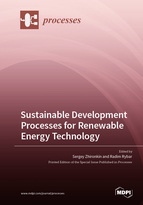Sustainable Development Processes for Renewable Energy Technology
A special issue of Processes (ISSN 2227-9717). This special issue belongs to the section "Energy Systems".
Deadline for manuscript submissions: closed (30 November 2021) | Viewed by 23053
Special Issue Editors
Interests: innovation economic; development economy innovation man-agement; higher education; environmental engineering; mining technology; innovation wastewater
Special Issues, Collections and Topics in MDPI journals
Interests: solar thermal collectors; innovations in renewable energy technologies
Special Issues, Collections and Topics in MDPI journals
Special Issue Information
Dear Colleagues,
Currently, the production of energy from traditional fossil sources is beginning to give way to renewable energy technologies. New technological, economic, and environmental requirements raise the question of how to make renewable energy sources a driver of sustainable development for the coming decades. Solar and wind energy, recycling of synthetic materials, and new ways for their utilization can not only significantly reduce the burden on the environment, but also give a new impetus to the development of modern industry and help find a new balance between the needs of people and the capabilities of nature.
To enhance the international dissemination of these ideas, it is necessary to unite the efforts of researchers in the fields of traditional and modern energy, waste-free production, and ecology in multidisciplinary discussions of urgent problems of transition to the use of renewable energy. In order to obtain new ideas in these areas worldwide, this Special Issue, entitled “Sustainable Development Processes for Renewable Energy Technology”, is proposed for the international journal Processes. This Special Issue mainly covers original research in the fields of sustainable development, new materials manufacturing and recycling, and renewable energy. We invite you to submit your original papers to the Special Issue “Sustainable Development Processes for Renewable Energy Technology” and look forward to receiving your outstanding research.
Prof. Dr. Sergey Zhironkin
Dr. Radim Rybar
Guest Editors
Manuscript Submission Information
Manuscripts should be submitted online at www.mdpi.com by registering and logging in to this website. Once you are registered, click here to go to the submission form. Manuscripts can be submitted until the deadline. All submissions that pass pre-check are peer-reviewed. Accepted papers will be published continuously in the journal (as soon as accepted) and will be listed together on the special issue website. Research articles, review articles as well as short communications are invited. For planned papers, a title and short abstract (about 100 words) can be sent to the Editorial Office for announcement on this website.
Submitted manuscripts should not have been published previously, nor be under consideration for publication elsewhere (except conference proceedings papers). All manuscripts are thoroughly refereed through a single-blind peer-review process. A guide for authors and other relevant information for submission of manuscripts is available on the Instructions for Authors page. Processes is an international peer-reviewed open access monthly journal published by MDPI.
Please visit the Instructions for Authors page before submitting a manuscript. The Article Processing Charge (APC) for publication in this open access journal is 2400 CHF (Swiss Francs). Submitted papers should be well formatted and use good English. Authors may use MDPI's English editing service prior to publication or during author revisions.
Keywords
- sustainable development
- renewable energy
- new materials
- recycling







